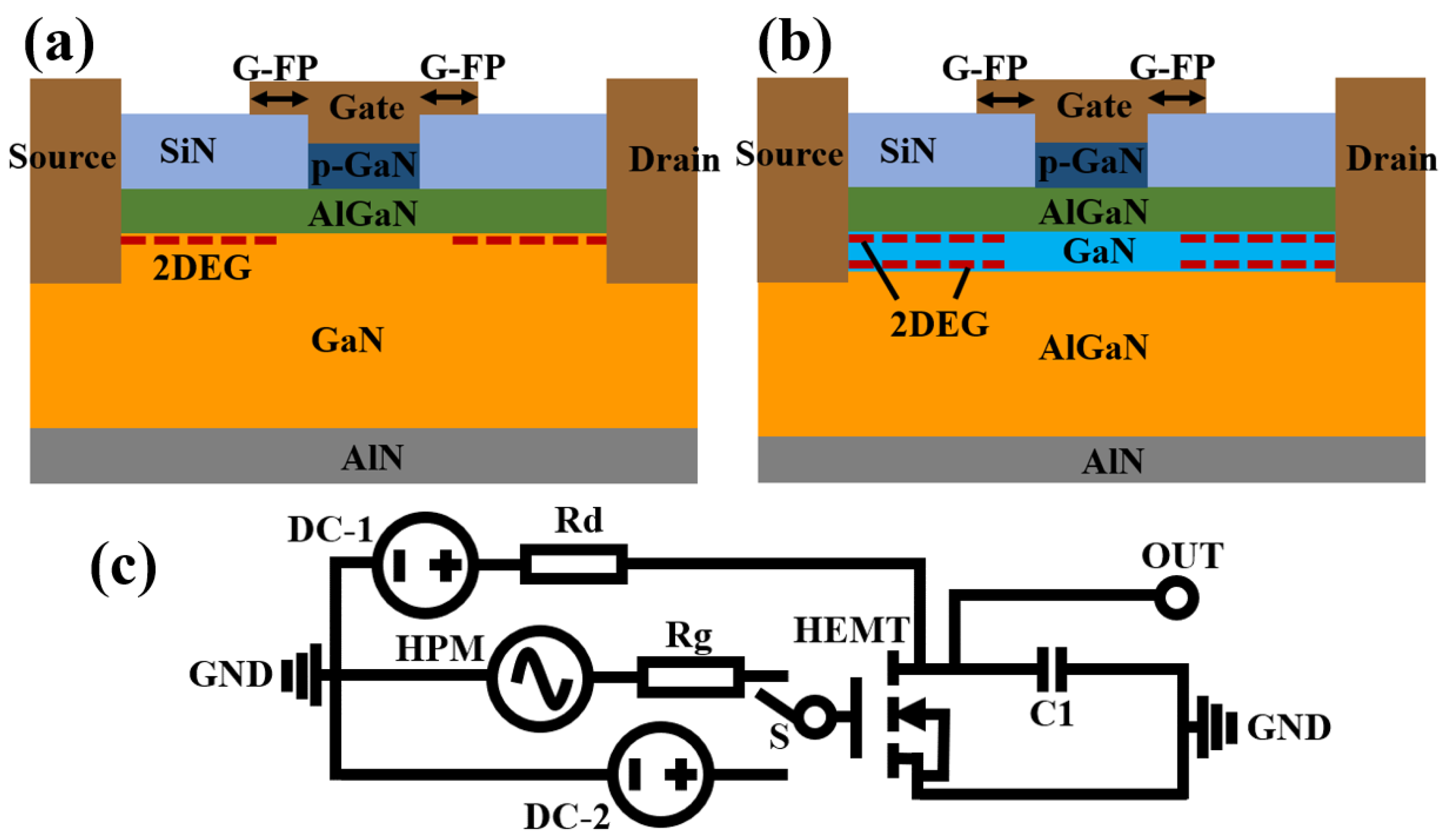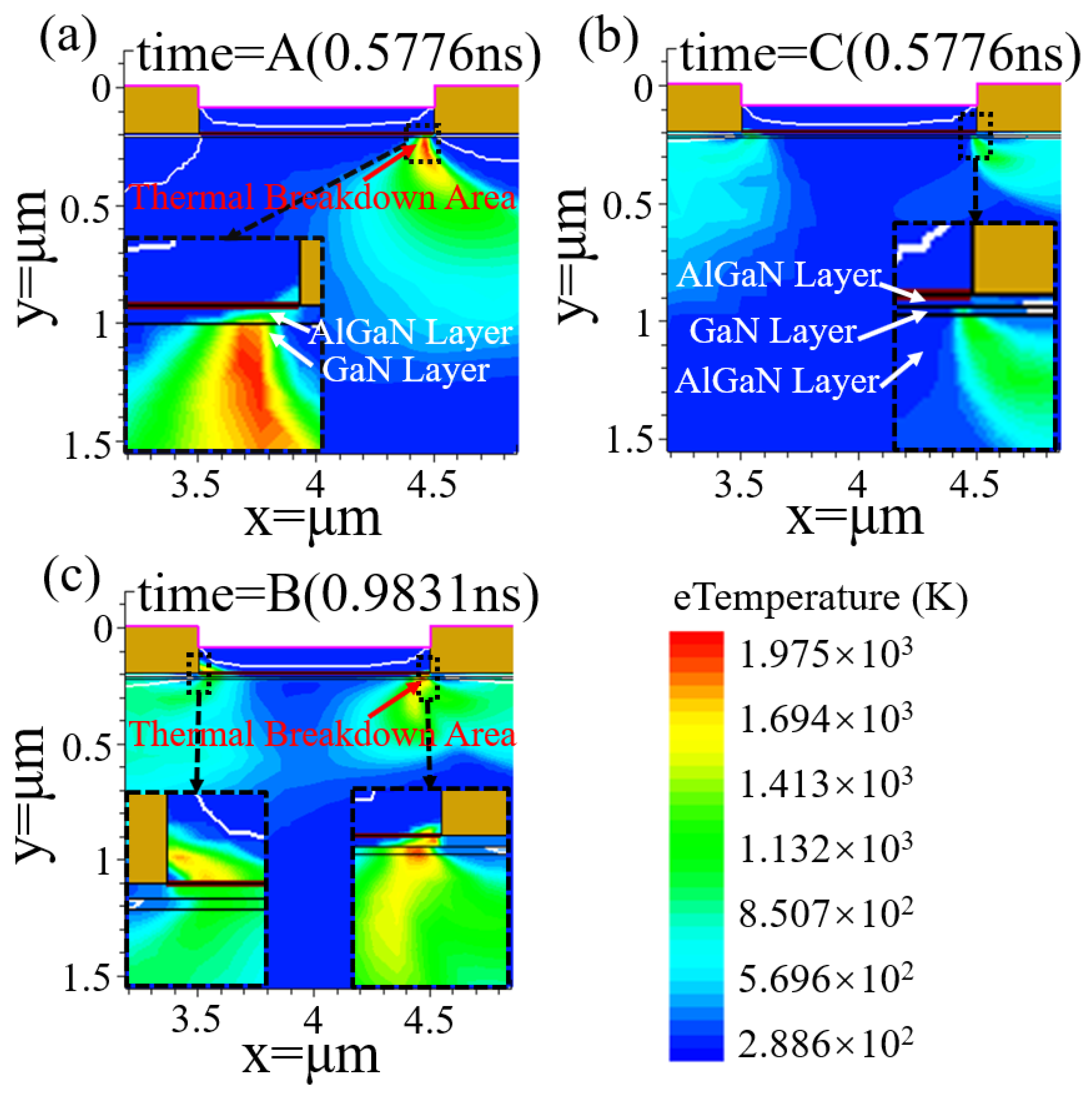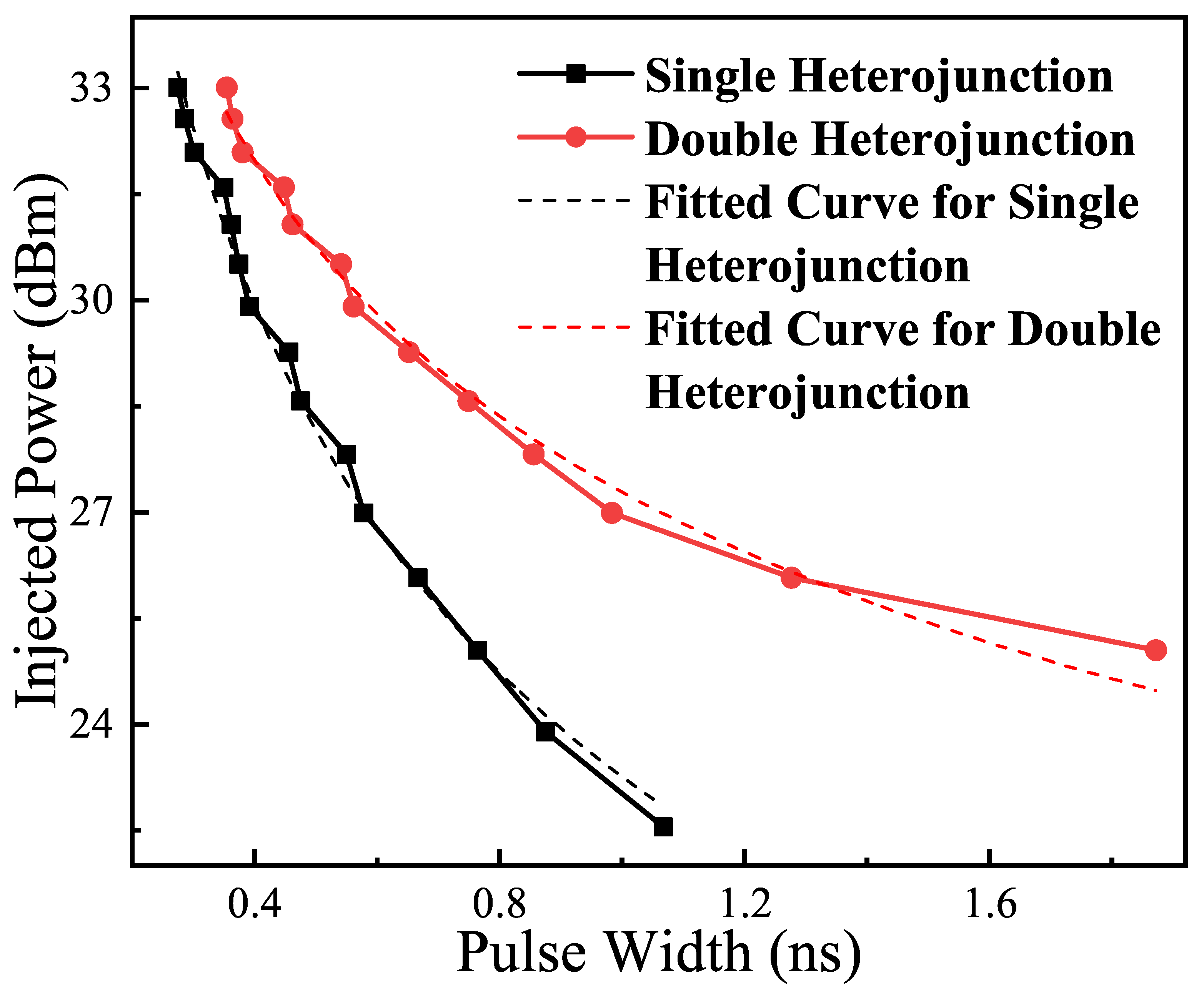Damage Effects and Mechanisms of High-Power Microwaves on Double Heterojunction GaN HEMT
Abstract
:1. Introduction
- A novel aviation nanodevice is designed in this study. The double heterojunction GaN HEMT device model established in this paper is a unique improvement and design based on the established and mature traditional GaN HEMT device model. The reliability of the device is ensured. The new improved design also meets industry standards. This improved design enhances the breakdown characteristics. The characteristics and principles of the breakdown resistance of double heterojunction devices were derived and confirmed through a comparative analysis method.
- The electromagnetic environmental effects of aviation nanomaterials are investigated in this paper. This paper focuses on a principled study to obtain the damage mechanism and thermal breakdown process of the device. The breakdown time of the device was used as a pivotal indicator, and the distribution of current density and temperature inside the device at different time points was investigated. The often overlooked Al component is investigated in this paper and the effect of the Al component on the breakdown of the device is studied.
- The electromagnetic sensitivity of aviation nanodevices to HPM signals was studied. The damage relationship of high-power microwave signals with different parameters with the device was obtained. Moreover, fitting equations with regularity were obtained.
2. Model Building
2.1. Device Models
2.2. Physical Models
2.3. Circuit Models
3. Results and Analysis
3.1. Physical Characteristics of the Device
3.2. Effect of Al Composition on Device Breakdown
3.3. Effect of Power and Pulse Width on Device Breakdown
3.4. Analysis and Discussion
3.4.1. Discussion on the Quality of the Applied Models
3.4.2. Discussion on Model Consistency Verification
4. Conclusions
Author Contributions
Funding
Data Availability Statement
Conflicts of Interest
References
- Filgueiras, H.; Marques, R.; Augusto, A.R.; Nunes, S.H.; de Faria, H.L.; Cerqueira, S.A. HIRF Broadband Full-Wave Virtual Testing and Experimental Validation. IEEE Electromagn. Compat. Mag. 2021, 10, 39–46. [Google Scholar] [CrossRef]
- Kadem, K.; Benyoubi, F.; Bensetti, M.; Bihan, Y.L.; Labouré, E.; Debbou, M. An Efficient Method for Dimensioning Magnetic Shielding for an Induction Electric Vehicle Charging System. Prog. Electromagn. Res. 2021, 170, 153–167. [Google Scholar] [CrossRef]
- Wu, Z.; Liu, P.; Deng, B.; Tian, T.; Zha, S.; Ni, X. An Ultrabroadband Energy Selective Surface with Nonreciprocal Performance for HIRF Protection. IEEE Trans. Electromagn. Compat. 2023, 65, 1202–1210. [Google Scholar] [CrossRef]
- Weinberg, G.V. Quantification of combat team survivability with high power rf directed energy weapons. Prog. Electromagn. Res. M 2021, 102, 1–11. [Google Scholar] [CrossRef]
- Marjanovic Cermak, A.M.; Pavicic, I.; Trosic, I. Oxidative stress response in SH-SY5Y cells exposed to short-term 1800 MHz radiofrequency radiation. J. Environ. Sci. Health Part A Toxic/Hazardous Subst. Environ. Eng. 2018, 53, 132–138. [Google Scholar]
- Ying, K.; Yu, X.; Shen, J.; Zhang, S.; Guo, Y. Intelligent Microwave Staring Correlated Imaging. Prog. Electromagn. Res. 2023, 176, 109–128. [Google Scholar] [CrossRef]
- Arpia, A.A.; Chen, W.H.; Lam, S.S.; Rousset, P.; Luna, M.D.G.D. Sustainable biofuel and bioenergy production from biomass waste residues using microwave-assisted heating: A comprehensive review. Chem. Eng. J. 2021, 403, 126233. [Google Scholar] [CrossRef]
- Xie, Y.; Li, Z.; Tang, J.; Li, P.; Chen, W.; Liu, P.; Li, L.; Zheng, Z. Microwave-assisted foaming and sintering to prepare lightweight high-strength polystyrene/carbon nanotube composite foams with an ultralow percolation threshold. J. Mater. Chem. C 2021, 9, 9702–9711. [Google Scholar] [CrossRef]
- Jafari, A.; Nikoo, M.S.; Perera, N.; Yildirim, H.K.; Karakaya, F.; Soleimanzadeh, R.; Matioli, E. Comparison of Wide-Band-Gap Technologies for Soft-Switching Losses at High Frequencies. IEEE Trans. Power Electron. 2020, 35, 12595–12600. [Google Scholar] [CrossRef]
- Wei, X.; Shen, W.; Zhou, X.; Tang, W.; Ma, Y.; Chen, T.; Wang, D.; Fu, H.; Zhang, X.; Lin, W.; et al. 2.69 kV/2.11 mΩ·cm and Low Leakage p-GaN Stripe Array Gated Hybrid Anode Diodes with Low Turn-on Voltage. IEEE Electron Device Lett. 2023, 44, 13–16. [Google Scholar] [CrossRef]
- Wang, Y.; Sun, H.; Zhao, Q.; Mao, Y.; Hou, Q. Study on Capability Verification Test of Electromagnetic Pulse Protection for Aircraft. In Proceedings of the 2022 Asia-Pacific International Symposium on Electromagnetic Compatibility (APEMC), Beijing, China, 8–11 May 2022; pp. 391–393. [Google Scholar] [CrossRef]
- Xiao, J.; Song, Z.; Wang, J.; Wang, L. Simulation Analysis of Electromagnetic Shielding of Electronic Device Chassis. In Proceedings of the 2019 12th International Workshop on the Electromagnetic Compatibility of Integrated Circuits (EMC Compo), Hangzhou, China, 21–23 October 2019; pp. 91–93. [Google Scholar] [CrossRef]
- Tallarico, A.N.; Stoffels, S.; Posthuma, N.; Decoutere, S.; Sangiorgi, E.; Fiegna, C. Threshold Voltage Instability in GaN HEMTs with p-Type Gate: Mg Doping Compensation. IEEE Electron Device Lett. 2019, 40, 518–521. [Google Scholar] [CrossRef]
- Hou, R.; Shen, Y.; Zhao, H.; Hu, H.; Lu, J.; Long, T. Power Loss Characterization and Modeling for GaN-Based Hard-Switching Half-Bridges Considering Dynamic on-State Resistance. IEEE Trans. Transp. Electrif. 2020, 6, 540–553. [Google Scholar] [CrossRef]
- Meguro, T.; Takeyama, A.; Ohshima, T.; Tanaka, Y.; Kuroki, S.I. Hybrid Pixels with Si Photodiode and 4H-SiC MOSFETs Using Direct Heterogeneous Bonding Toward Radiation Hardened CMOS Image Sensors. IEEE Electron Device Lett. 2022, 43, 1713–1716. [Google Scholar] [CrossRef]
- Wu, H. Research on the Characteristics of GaN DHEMT. Master’s Thesis, Xi’an University of Technology, Xi’an, China, 2024. [Google Scholar]
- Moon, J.S.; Grabar, B.; Wong, J.; Chuong, D.; Arkun, E.; Morales, D.V.; Chen, P.; Malek, C.; Fanning, D.; Venkatesan, N.; et al. Power Scaling of Graded-Channel GaN HEMTs with Mini-Field-Plate T-gate and 156 GHz fT. IEEE Electron Device Lett. 2021, 42, 796–799. [Google Scholar] [CrossRef]
- Ahmeda, K.; Ubochi, B.; Alqaysi, M.; Al-Khalidi, A.; Kalna, K. The role of SiN/GaN cap interface charge and GaN cap layer to achieve enhancement mode GaN MIS-HEMT operation. Microelectron. Reliab. 2020, 115, 113965. [Google Scholar] [CrossRef]
- Zhang, L.; Zheng, Z.; Yang, S.; Song, W.; Chen, K.J. p-GaN Gate HEMT with Surface Reinforcement for Enhanced Gate Reliability. IEEE Electron Device Lett. 2020, 42, 22–25. [Google Scholar] [CrossRef]
- Song, W.; Zheng, Z.; Chen, T.; Wei, J.; Yuan, L.; Chen, K.J. RF Linearity Enhancement of GaN-on-Si HEMTs with a Closely Coupled Double-Channel Structure. IEEE Electron Device Lett. 2021, 42, 1116–1119. [Google Scholar] [CrossRef]
- Kamath, A.; Patil, T.; Adari, R.; Bhattacharya, I.; Ganguly, S.; Aldhaheri, R.W.; Hussain, M.A.; Saha, D. Double-Channel AlGaN/GaN High Electron Mobility Transistor with Back Barriers. IEEE Electron Device Lett. 2012, 33, 1690–1692. [Google Scholar] [CrossRef]
- Yang, L.; Changchun, C.; Xinhai, Y.; Qingyang, F.; Yintang, Y.; Xiaowen, X.; Shengbei, L. Damage effects and mechanism of the GaN high electron mobility transistor caused by high electromagnetic pulse. Acta Phys. Sin. 2016, 65, 038402. [Google Scholar] [CrossRef]
- Synopsys. SentaurusTM Device User Guide; Synopsys: Tokyo, Japan, 2018. [Google Scholar]
- Yu, X.; Ma, Z.; Chai, C.; Shi, C.; Wang, P. Nonlinear and Permanent Degradation of GaAs-Based Low-Noise Amplifier Under Electromagnetic Pulse Injection. IEEE Trans. Electromagn. Compat. 2020, 62, 101–107. [Google Scholar] [CrossRef]
- Meneghesso, G.; Meneghini, M.; Zanoni, E. Breakdown mechanisms in AlGaN/GaN HEMTs: An overview. Jpn. J. Appl. Phys. 2014, 53, 100211. [Google Scholar] [CrossRef]
- Changchun, C.; Xiaowen, X.; Xingrong, R.; Yintang, Y.; Zhenyang, M. The damage effect and mechanism of the bipolar transistor induced by the intense electromagnetic pulse. Acta Phys. Sin. 2010, 59, 8118–8124. [Google Scholar] [CrossRef]
- Xiaowen, X.; Changchun, C.; Xingrong, R.; Yintang, Y.; Bing, Z. EMP injection damage effects of a bipolar transistor and its relationship between the injecting voltage and energy. J. Semicond. 2010, 31, 44005. [Google Scholar] [CrossRef]
- Brown, W.D. Semiconductor Device Degradation by High Amplitude Current Pulses. IEEE Trans. Nucl. Sci. 1972, 19, 68–75. [Google Scholar] [CrossRef]
- Wunsch, D.C.; Bell, R.R. Determination of Threshold Failure Levels of Semiconductor Diodes and Transistors Due to Pulse Voltages. IEEE Trans. Nucl. Sci. 1968, 15, 244–259. [Google Scholar] [CrossRef]
- Zhou, L.; San, Z.W.; Hua, Y.J.; Lin, L.; Zhang, S.; Zhao, Z.G.; Zhou, H.J.; Yin, W.Y. Investigation on Failure Mechanisms of GaN HEMT Caused by High-Power Microwave (HPM) Pulses. IEEE Trans. Electromagn. Compat. 2017, 59, 902–909. [Google Scholar] [CrossRef]







| Thickness | Doping Type | Doping Concentration | Al Component | |
|---|---|---|---|---|
| AlN layer | 10 nm | |||
| GaN buffer layer (single heterojunction) | 2.01 μm | arsenic atoms | 1 × 1014 cm−3 | |
| AlGaN buffer layer (double heterojunction) | 2.00 μm | arsenic atoms | 1 × 1014 cm−3 | Al0.05Ga0.95N |
| GaN channel layer (double heterojunction) | 0.01 μm | arsenic atoms | 1 × 1015 cm−3 | |
| AlGaN barrier layer | 15 nm | arsenic atoms | 1 × 1018 cm−3 | Al0.23Ga0.77N |
| SiN passivation layer | 0.2 μm | |||
| p-GaN gate cap layer | 0.11 μm | boron atoms | 3 × 1017 cm−3 | |
| Length of electrodes | gate: 1.0 μm; drain = source: 0.5 μm | |||
| Electrode distance | gate-source distance = gate-drain distance: 3.0 μm | |||
| G-FPs | 0.5 μm | |||
| Thermal contact | 300 K | |||
Disclaimer/Publisher’s Note: The statements, opinions and data contained in all publications are solely those of the individual author(s) and contributor(s) and not of MDPI and/or the editor(s). MDPI and/or the editor(s) disclaim responsibility for any injury to people or property resulting from any ideas, methods, instructions or products referred to in the content. |
© 2024 by the authors. Licensee MDPI, Basel, Switzerland. This article is an open access article distributed under the terms and conditions of the Creative Commons Attribution (CC BY) license (https://creativecommons.org/licenses/by/4.0/).
Share and Cite
Ma, Z.; Liu, D.; Yuan, S.; Duan, Z.; Wu, Z. Damage Effects and Mechanisms of High-Power Microwaves on Double Heterojunction GaN HEMT. Aerospace 2024, 11, 346. https://doi.org/10.3390/aerospace11050346
Ma Z, Liu D, Yuan S, Duan Z, Wu Z. Damage Effects and Mechanisms of High-Power Microwaves on Double Heterojunction GaN HEMT. Aerospace. 2024; 11(5):346. https://doi.org/10.3390/aerospace11050346
Chicago/Turabian StyleMa, Zhenyang, Dexu Liu, Shun Yuan, Zhaobin Duan, and Zhijun Wu. 2024. "Damage Effects and Mechanisms of High-Power Microwaves on Double Heterojunction GaN HEMT" Aerospace 11, no. 5: 346. https://doi.org/10.3390/aerospace11050346






